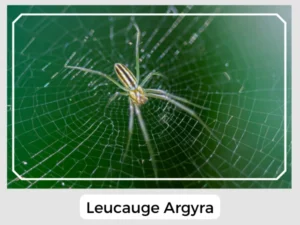Step into the world of Leucauge argyra! This spider is a part of the long-jawed orb weavers family. What’s interesting is its connection with the Costa Rican wasp Hymenoepimecis argyraphaga. We’ve gathered some cool facts about this spider for you to discover.
The eggs of these spiders are primarily made of protein and fat. Their size depends on the mother’s food, with larger eggs being produced if she consumes her mate after reproducing.
Hatchlings are spotted on the lower positions of the web.
The webs of these spiders have several levels, with the adults occupying higher positions while the spiderlings are seen on the lower parts of the net.
Yes, Leucauge argyra spiders do have venom. They use it mainly to help catch the little bugs they eat. For most people, this venom isn’t a big deal.
Yes, they can! But Leucauge argyra spiders are usually pretty peaceful. They might bite if they feel scared, but often, they just focus on their webs and bug-catching.
Leucauge argyra spiders are integral to the ecosystem, helping to control insect populations through their predatory habits. Their complex webs are not only feats of natural engineering but also serve as a critical part of their survival strategy, enabling them to capture a variety of prey.
Natural Predator: A notable natural predator is the parasitoid wasp Hymenoepimecis argyraphaga, which has a unique parasitic relationship with the spider, influencing its web construction for the wasp’s reproductive needs.
Prey-Predator Dynamics: In the delicate balance of their ecosystems, Leucauge argyra spiders are both hunters and hunted. Their role as predators helps manage insect populations, while their interactions with parasitoid wasps reflect the intricate connections within their environment.
Relationship with Humans: Humans rarely interact directly with Leucauge argyra spiders, as these creatures tend to keep to their natural habitats. However, their presence is beneficial to humans, as they help in reducing the populations of insects, including those that are pests.
| Lifespan | Around 1 year |
| Distribution | Asia, Brazil, and the United States |
| Habitat | Weeds and wooded streams |
| Common Predators | Parasitoid wasps, most notably Hymenoepimecis argyraphaga |
| Diet | Insects |

In summary, the Leucauge argyra spider is a vital component of its habitat, contributing to the control of insect populations and providing a window into the complex interactions of natural ecosystems.
Step into the world of Leucauge argyra! This spider is a part of the long-jawed orb weavers family. What’s interesting is its connection with the Costa Rican wasp Hymenoepimecis argyraphaga. We’ve gathered some cool facts about this spider for you to discover.
The eggs of these spiders are primarily made of protein and fat. Their size depends on the mother’s food, with larger eggs being produced if she consumes her mate after reproducing.
Hatchlings are spotted on the lower positions of the web.
The webs of these spiders have several levels, with the adults occupying higher positions while the spiderlings are seen on the lower parts of the net.
Yes, Leucauge argyra spiders do have venom. They use it mainly to help catch the little bugs they eat. For most people, this venom isn’t a big deal.
Yes, they can! But Leucauge argyra spiders are usually pretty peaceful. They might bite if they feel scared, but often, they just focus on their webs and bug-catching.
Leucauge argyra spiders are integral to the ecosystem, helping to control insect populations through their predatory habits. Their complex webs are not only feats of natural engineering but also serve as a critical part of their survival strategy, enabling them to capture a variety of prey.
Natural Predator: A notable natural predator is the parasitoid wasp Hymenoepimecis argyraphaga, which has a unique parasitic relationship with the spider, influencing its web construction for the wasp’s reproductive needs.
Prey-Predator Dynamics: In the delicate balance of their ecosystems, Leucauge argyra spiders are both hunters and hunted. Their role as predators helps manage insect populations, while their interactions with parasitoid wasps reflect the intricate connections within their environment.
Relationship with Humans: Humans rarely interact directly with Leucauge argyra spiders, as these creatures tend to keep to their natural habitats. However, their presence is beneficial to humans, as they help in reducing the populations of insects, including those that are pests.
| Lifespan | Around 1 year |
| Distribution | Asia, Brazil, and the United States |
| Habitat | Weeds and wooded streams |
| Common Predators | Parasitoid wasps, most notably Hymenoepimecis argyraphaga |
| Diet | Insects |

In summary, the Leucauge argyra spider is a vital component of its habitat, contributing to the control of insect populations and providing a window into the complex interactions of natural ecosystems.